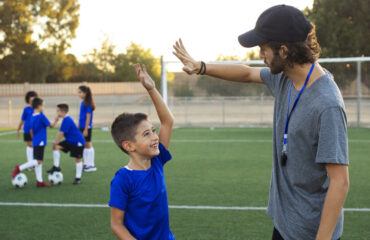
Building a strong sports culture in India is a complex challenge, shaped by deep-rooted societal attitudes, educational structures, and infrastructure limitations. While India is home to immense talent and potential, practical barriers often prevent young athletes from pursuing sports with the freedom and support seen in other parts of the world. In countries like those in Europe, sports are seamlessly integrated into daily life, supported by holistic systems that encourage balanced growth and exploration. By examining the cultural, educational, and infrastructural differences, we can gain insights into why India struggles to foster a thriving sports environment—and what steps might be taken to overcome these challenges.
Cultural Disconnect and Lack of Family Involvement
Europe: In Europe, sports are deeply embedded in family life, with the whole family often involved as fans and supporters. Love for a club or a particular sport is passed down through generations, creating a strong, shared passion that binds families together. This multigenerational enthusiasm means that sports are not just an activity but a cherished family tradition. Parents, siblings, and extended family members actively participate, whether by attending games, cheering from the stands, or encouraging young athletes at every stage of their journey. This unified family support reinforces a young athlete’s commitment and motivation.
India: In contrast, sports are rarely woven into the fabric of family life in India. While one parent may be supportive, the entire family rarely shares a collective passion for a sport or team. Often, the responsibility of taking the child to practice falls on one parent and is sometimes viewed as a burdensome chore rather than a shared activity. Without this generational enthusiasm and collective family involvement, young athletes in India may lack the emotional and practical support that helps nurture a lifelong passion for sports. For a true sports culture to develop, families must view sports as a unifying experience rather than an individual pursuit.
Sports as an Integrated Part of Life vs. Career Pressure
Europe: In Europe, sports are deeply woven into the daily lifestyle of children. From a young age, sports are seen as an enjoyable and natural part of growing up, with schools, clubs, and communities providing ample opportunities to play and develop skills in a stress-free environment. Children participate in sports not just to “become athletes” but because they genuinely enjoy it. This ingrained sports culture allows them to grow up loving the game, without feeling pressured to turn it into a career. A strong sports culture gives children room to explore various interests, balancing sports, academics, and other activities with ease.
India: In India, sports are often viewed through the lens of career-building, and the pressure to excel can overshadow the joy of playing. When a child shows promise in sports, the focus often shifts toward making it a career path rather than letting the child simply enjoy and learn from the experience. This creates an atmosphere where sports feel like a task rather than a passion, and young athletes may face pressure to perform rather than develop a love for the game. In a country with a budding sports culture, creating a balance where sports can be pursued freely without career expectations is essential for nurturing long-term engagement and genuine passion among children.
Holistic Lifestyle and Comprehensive Development
Europe: European society embraces a holistic lifestyle that values balanced development, which is reflected in how sports programs and education systems function. From a young age, children are encouraged to engage in various activities, with sports seen as an essential part of personal growth rather than just performance. Training programs focus not only on athletic skills but also on life skills, mental well-being, teamwork, and discipline. This holistic approach shapes well-rounded individuals prepared for both the sports world and life beyond it, as the entire society supports balanced, all-encompassing development.
India: In India, sports training often emphasises performance and results, with less focus on the comprehensive development of young athletes. The broader society tends to prioritise academic and career achievements, which can result in a narrow focus on immediate sports performance rather than long-term personal growth. As a result, young athletes may miss out on important aspects of development, such as mental resilience, social skills, and emotional well-being. For sports culture to thrive, it’s crucial to shift toward a more holistic approach that nurtures the individual as a whole, beyond just athletic success.
Flexible Education Systems vs. Academic Pressure
Europe: The education system in many European countries is more relaxed and flexible, allowing young athletes ample room to explore sports and other interests. Schools understand the importance of a balanced development, encouraging students to pursue sports without compromising their academic growth. This flexibility enables athletes to train and compete freely, balancing their studies with their athletic ambitions and other pursuits.
India: In India, even in some of the best schools, the education system is heavily academic-focused, with a rigid curriculum that leaves little room for students to freely pursue sports. The pressure to excel in academics often overshadows other interests, making it difficult for young athletes to dedicate time to training and development. This academic-heavy approach restricts students’ ability to explore sports and hampers the natural integration of athletics into their daily lives. For a thriving sports culture, it’s crucial to create a system that allows students to pursue sports without academic constraints weighing them down.
Read more: How Relocating to Europe Helps Aspiring Footballers Achieve Their Dreams
Infrastructure Accessibility and Commute Challenges
Europe: In Europe, sports facilities are integrated within communities, with easy access to fields, gyms, and clubs. Public transportation systems are well-connected, making it convenient for young athletes to commute to training locations. This accessible infrastructure encourages regular participation, as parents feel more at ease with safe, short commutes and readily available facilities, allowing children to pursue sports consistently.
India: In India, infrastructure limitations and heavy traffic in urban areas make accessing sports facilities challenging. Young athletes often need to travel long distances through congested roads to reach training centres, consuming time and energy. This daily hassle discourages regular attendance, and many parents are dissuaded from encouraging their children to pursue sports due to the inconvenience and safety concerns associated with long commutes. The lack of easily accessible facilities not only limits training consistency but also affects parents’ willingness to support their child’s sports journey.



